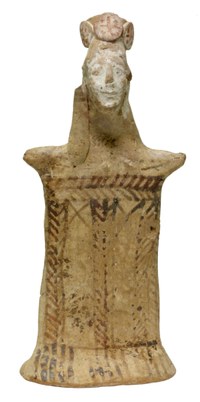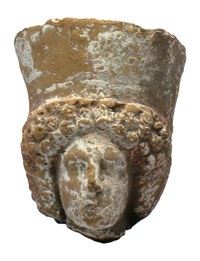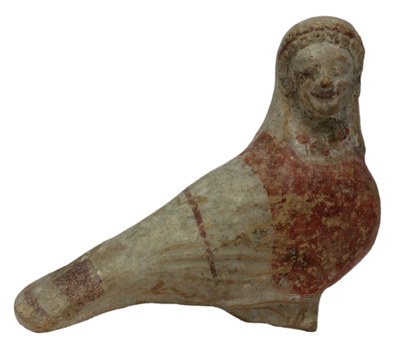Boeotia
 |
 |
 |
 |
 |
 |
 |
 |
 |
 |
 |
|
Boeotia, the landscape bordering Attica in the north-west, is the home of famous figures of antiquity, such as Hesiod (Chalkis/Euboea), Pindar (Kynoskephalai near Thebes), Plutarch (Cheironeira) or the poetess Korinna (Tanagra). In general, however, the Boeotians were considered provincial, backward and devoid of any creative impulse[1]. They were said to lack cosmopolitanism, forgetting that the first colonies in the West, Kyme/Cumae in Campania and Naxos and Zankle/Messina in Sicily, had come from Boeotia and Euboea respectively. All artistic innovations were achievements of the workshops of Corinth, Ionia or Attica. The Boeotians had merely imitated them, while their own contribution had consisted in the 'art' of tradition and retardation[2].
Occasionally there were also other voices. Gisela M. A. Richter highlighted the extensive Boeotian production of terracottas and ceramic vessels, especially in the 7th century BC. Thus, the bird-headed statuettes and "pappades" were characteristic of the coroplastics of Boeotia, even though they were often found outside the country[3]. R. Lullies even saw something positive in the term "provincial style" ... often applied to Boeotian art "insofar as the provincial artist adds a new constant to his works ... no matter how closely he depends on his model"[4]. E. Paul emphasised the pre-eminence of Boeotia with regard to the pappades[5]. Although they were based on Corinthian models, they were then transformed into something completely new. The bird-headed idols[6] in particular have no equivalent. In his study of the Boeotian coroplastic of the 7th and 6th centuries BC, M. Szabó proves[7] that the anthropomorphic statuettes were not a mere adoption either. After the regional workshops had made their selection from the offerings of famous foreign manufacturers, the models were then worked on and reshaped so thoroughly that characteristic sculptures of their own unique charm were created[8]. W. Schild-Xenidou shows for the archaic and classical relief sculpture of Boeotia "that this country, in addition to being shaped by Ionic and Attic influences, actually also developed and preserved an intellectual-artistic independence"[9]. As examples of this, he again cites the archaic bird-head idols or, in classical times, statuettes with a polos that is additionally provided with a towering serrated decorative plate, a specifically Boeotian feature[10]. Later, the distinctively Boeotian female and youth figurines with "rich hairstyles" emerge[11].
Pappades
Board-like flat terracottas, which rarely exceed a height of 20 cm, were created mainly in the 6th century B.C. As floor-length robes and applied breasts or breasts indicated in painting[12] show, they are the representation of women. A high polos, reminiscent of the headgear of "pappas", i.e. Orthodox priests, earned the iconographically similarly crowned statuettes their name[13]: Apart from the idols with bird-beaked stylised heads[14] ("bird-headed idols"), specimens with human faces emerged, which, in contrast to the mostly hand-made bodies, were obtained from matrices. In comparison with the faces of vessel figures from the beginning of the 6th century BC, F. R. Grace showed the close connection of the contemporaneous Boeotian idols to Corinthian pottery and coroplastics[15]. Before the second kilning, the statuettes received a careful decoration of geometric motifs in bright colours. The robes widen downwards to form an oval standing ring so that the figures can stand without support. Long shoulder hair is often plastically indicated[16].
Other idols with human heads usually need a support to stand upright because of their shallow depth[17]. The painting in delicate pastel shades, applied after kilning on a white ground, is often poorly preserved[18].
Between these two groups of idols, distinguished by their anthropomorphic faces, stands a less homogeneous intermediate group[19], in which the statuette Giessen T I-2 also finds its place.
[1] DNP 2, 734-738; 4, 207; 6, 738.
[2] W. Martini, Sachwörterbuch der Klassischen Archäologie (Stuttgart 2003) 40; id., Die Archaische Plastik der Griechen (Darmstadt 1990) 208.
[3] G. M. A. Richter, Handbuch der griechischen Kunst (Köln – Berlin – Nimwegen 1966) 258 f.; M. Szabó, Archaic Terracottas of Boeotia (Rom 1993) 21 note 1.
[4] R. Lullies, Zur frühen boiotischen Plastik, JdI 51, 1936, 137.
[5] Idol = Bild, Abbild. E. Paul, Die böotischen Brettidole. Diss. Leipzig 1958, 4. 79-83.
[6] Paul ibid. 79.
[7] „Adoption of Corinthian elements, employed in an independent manner“, M. Szabó, Archaic Terracottas of Boeotia (Rom 1993) 50.
[8] Szabó ibid. 134.
[9] W. Schild-Xenidou, boiotische Grab- und Weihreliefs archaischer und klassischer Zeit, Diss. München 1972, 1.
[10] z. B. K. Demakopoulou – D. Konsola, Archäologisches Museum Theben (Athen 1981) 65 fig. 21; W. Schürmann, Katalog der antiken Terrakotten im Badischen Landesmuseum Karlsruhe (Göteborg 1989) 38 f. no. 81 pl. 17. The motif of the decorative plate leads to the question of whether it is perhaps a metaphor for the kanoun (the sacrificial basket), see e.g. Schürmann 1989, 40 f. no. 86 pl. 18; U. Liepmann, Griechische Terrakotten, Bronzen, Skulpturen (Hannover 1975) 18. 61 T 45; F. W. Hamdorf, Hauch des Prometheus (München 1996) 50, fig. 50; J. G. Szilágyi – L. Castiglione, Görög-Római Kiállítás vezető (Budapest 1955) 25 pl. 13, 2.
[11] L. Frey-Asche, Tonfiguren aus dem Altertum (Hamburg 1997) 50 f. no. 30; M. Maischberger, Was sind Männer? In: Die griechische Klassik. Idee oder Wirklichkeit (Berlin 2002) 282-284 nos. 173-176.
[12] G. Zahlhaas, Idole. Frühe Götterbilder und Opfergaben (Mainz 1985) 89 fig. 36 and pl. 24; F. R. Grace, Archaic Sculpture in Boeotia (Rom 1969) 85 figs. 29. 30.
[13] „Pappades“, Grace 1969, 27 figs. 37. 38; M. Szabó, Archaic Terracottas of Boeotia (Rom 1994) 10.
[14] Zahlhaas 1985, 87 f. fig. 34.
[15] e.g. Pyxis Berlin, Grace 1969, 31 figs. 20. 21.
[16] Grace 1969, 85 f. figs. 29. 31. 33. 38
[17] Paul 1958, 59.
[18] Grace 1969, 46 figs. 58. 59; L. I. Marangou, Archaia ellenike techne (Athen 1985) 129 figs. 187-190; Schürmann 1989, 28 f. no. 39 pl. 10; P. N. Ure, Aryballoi & Figurines from Rhitsona in Boeotia (Cambridge 1934) 59 no. 112 pl. 14.
[19] Szabó's group of "standing pappades of a transitional nature" is characterised by a "mouse-like face", sculpted strands of hair and short, pointed arm stumps. The geometric decoration is often limited to the chest area, Szabó 1994, 64 f. figs. 63-66.
